You might already be using mobile channels like SMS, MMS, WhatsApp, or others to have conversations with your customers. And you may be doing a great job at it! But what if we told you there’s another mobile strategy around that’s proven time and time again to help increase conversions and sales? It's called RCS marketing.
RCS stands for Rich Communication Services, and it’s a messaging protocol that was designed to replace SMS and MMS. This new communication standard is changing the way businesses and their customers communicate with real-time, trusted, interactive chats that include multimedia.
Think of it as being able to show off products to your subscribers with flashy carousels, and letting them buy right there in their phone’s native messaging app. Sounds great, right? Get ready – because it’s about to change the game.
In this post, we’ll show you how RCS marketing can help level up your mobile marketing strategy with help from some awesome brands that are already using it.
What is RCS marketing?
RCS marketing refers to how businesses use RCS Business Messaging (RBM) to send engaging, interactive messages to customers. Sending mobile marketing campaigns via RCS means you can use features like rich media, interactive carousels, maps, suggested replies, and interactive buttons to drive engagement and meaningful interactions. Plus, since RCS includes branded, verified profiles, RCS marketing messages are less likely to be deleted as spam.
RCS vs SMS marketing
SMS is a staple in business communication, relied upon by billions worldwide. But despite its widespread use, it has some limitations. Take SMS marketing, for instance, where you’re limited to 160 characters per message. Meanwhile RCS messages don’t have a character limit. That can make a big difference for conversational marketing!
But the differences between these two channels go far beyond character limits. For quick reference, this table compares RCS and SMS for your marketing endeavors:
|
|
RCS marketing |
SMS marketing |
|
Reach |
RCS has over one billion active users worldwide. |
Every mobile phone on the planet can receive SMS (that’s 7.3 billion people!). |
|
Message format |
Supports rich media like images, videos, and carousels which can help enhance storytelling opportunities. |
Plain text; no images can be included (but you can send images and videos with MMS marketing). |
|
Open rate |
Very high – 90% of rich media messages are opened within 15 minutes. |
Very high – historically has had an open rate of over 90%. |
|
Interactivity |
Suggested replies and in-app wallet integration streamlines engagement and purchasing directly in the native messaging app. |
89% of consumers want two-way conversations via messaging channels, and SMS offers a path to achieve this. |
|
Branding opportunities |
All messages include a brand logo and verified sender information. |
Some countries allow Alpha Sender IDs. Only available in select markets and rules differ about when these can be used. |
|
Analytics |
Offers handset delivery receipts, open rates, and read rates. |
SMS marketing tools can offer SMS insights into basic delivery rates, including how many messages were delivered, how many failed to be delivered, and others depending on your provider. |
Some people think that SMS is a replacement for RCS, but we think of it as complementary. Basically, when you send RCS marketing messages through a provider like Sinch, undelivered RCS messages automatically convert to SMS (or another conversational messaging channel of your choosing). We’ll go more into this later.
Benefits of RCS marketing
Using RCS in your marketing strategy will help you send more interactive content, resulting in a better customer experience. Here are a few other benefits that an RCS marketing strategy can help you with.
Build trust with branded messages
71% of customers say they’ll stop buying from a company altogether if their trust is broken. And with mobile spam messages increasing year over year, making sure your customers know that your brand and its messages are genuine is becoming even more important.
RCS verified sender profiles provide a solution for building trust by showing recipients a logo, an official brand name, color, and distinct checkmark in all messages they receive. All of these visual cues signal that the messages come from a genuine source.
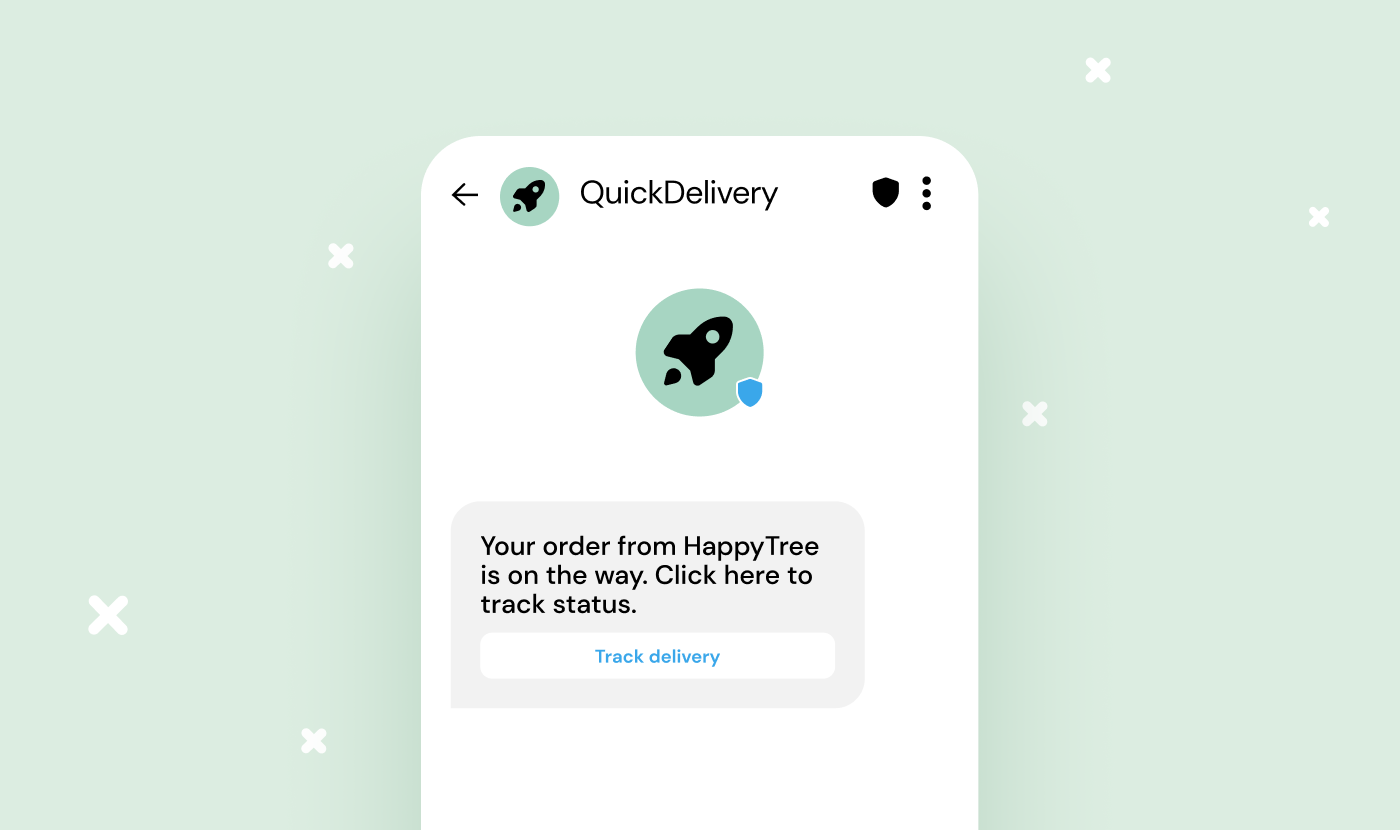
RCS branded messages mitigate the risk of your messages being overlooked or marked as spam.
Massive reach
RCS statistics show the massive potential of RCS, with more than one billion monthly active users with RCS enabled. Just think: Tapping into this user base could unlock growing opportunities for customer engagement, especially when all modern Android phones ship with Google Messages as the default texting app.
And with Apple support for RCS expected this year, this opportunity only grows, particularly in markets with substantial iOS penetration like the United States.
Increased engagement
RCS can help your brand deliver visually appealing, branded messages to your audience and create a genuine connection. And when paired with compelling content and targeted messaging, you’re sure to see an increase in engagement as well! That must be why RCS has better engagement than other types of mobile messaging (and people engage with RCS content for up to 45 seconds!).
Easy SMS upgrade
If you’re already doing SMS marketing, auto-upgrading from SMS to RCS is easy and is a common path for businesses looking to enhance their messaging capabilities. This basically means that messages suitable for RCS will be sent, while others will automatically revert to SMS (or another messaging channel).
How does this work? Well, first, working with an SMS provider simplifies the process, allowing quick setup of your RCS sender identity. For example, when you send RCS with Sinch, you can choose to upgrade your SMS messages or use RCS as part of our omnichannel Conversation API – meaning that you’ll have just one API that you use to turn on many different messaging channels like SMS, RCS, WhatsApp, and more.
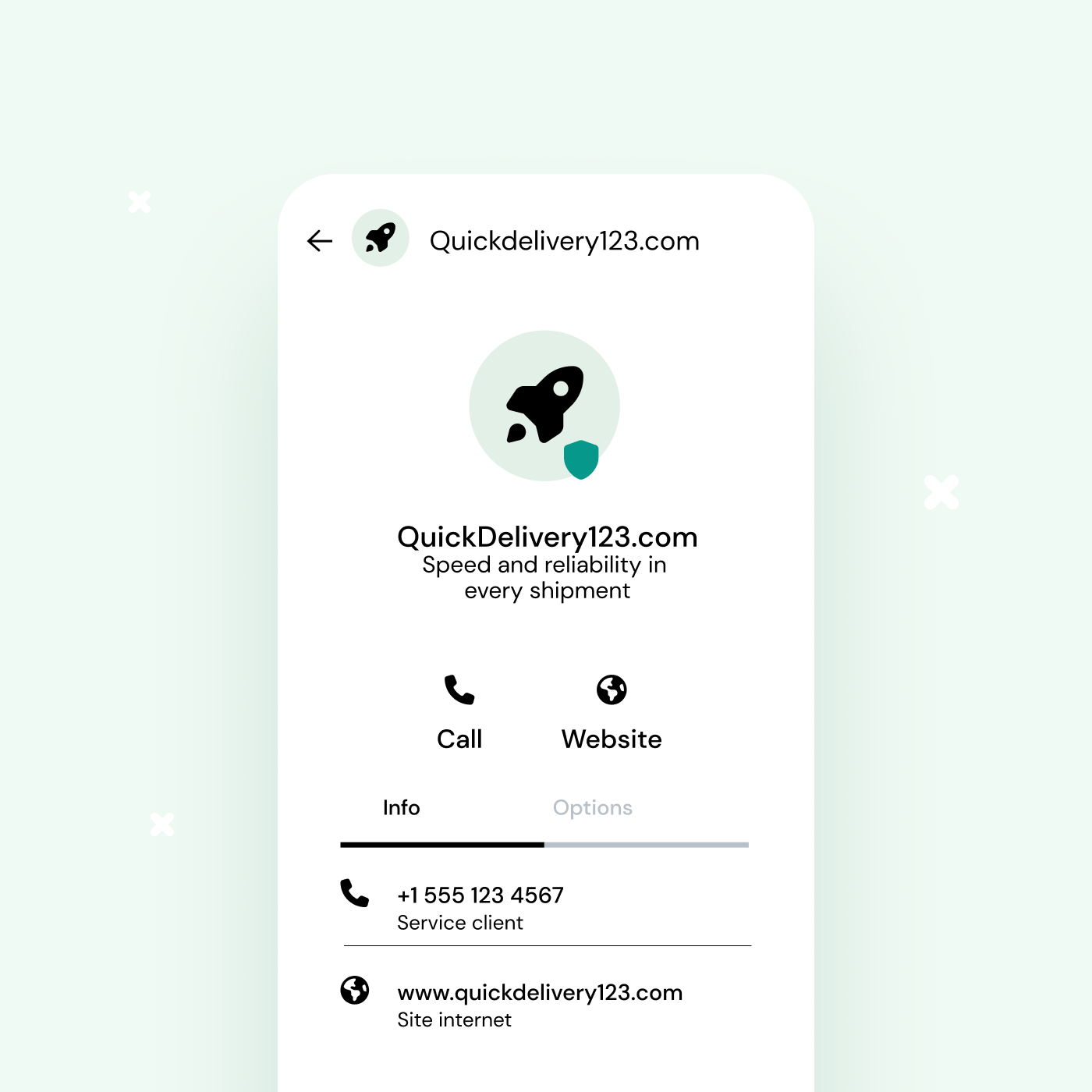
Setting up your brand’s sender profile is required before you can send your first RCS marketing campaign.
Ready to set up your RCS sender identity? Contact our team to get started.
Important for an omnichannel marketing strategy
89% of your customers want to have two-way conversations via messaging channels and apps. You should be thinking about RCS not only as a standalone channel but also as a part of your omnichannel marketing strategy to engage customers across their favorite channels. When you use RCS in Conversation API, you can easily add other messaging channels (like WhatsApp, Telegram, and more than a dozen others) that your customers want to use to talk to you.
Best practices for RCS marketing
Another great thing about RCS messaging is that opt-in consent is baked into the protocol – that is, RCS Business Messaging requires explicit consent from your recipients before you can send them marketing messages. This way, you’re always sending messages to people who want to hear from you.
With consent out of the way, what else should you be keeping in mind when you’re sending RCS marketing messages? Here are a few best practices.
-
Choose the right use case based on your business goals. You’ll need to choose to send your recipients push (one-way) notifications or conversational (two-way) messages via RCS, and the best way to do this is to have a clear understanding before you begin about your goals and objectives.
-
Segment your audience. Segmenting your audience based on age, shopping habits, or other factors can help make sure your marketing messages resonate.
-
Aim for personalization. You can (and should!) use RCS’ interactive nature for cross-selling and upselling, or you can personalize images in an RCS carousel to match your subscribers’ gender, location, or interests.
-
Know your data privacy and compliance responsibilities. Make sure that your messaging provider’s data handling practices align with your business standards and comply with relevant regulations.
Learn more best practices to master your RCS branded messages strategy in our guide written with mobile messaging experts.
6 ways to use RCS for marketing (with examples)
RCS offers countless opportunities to engage your customers with a great mobile marketing campaign. Here are a few ways you can use RCS in your marketing strategy, with examples from brands that saw great results!
1. Seasonal sales and promotions
When the holidays feel like they’re right around the corner, RCS can be a great channel to make your messages stand out from the competition.
You can use RCS to send your customers festive greetings, holiday updates, or even event invitations. And what makes it most exciting for seasonal sales is its interactive two-way messaging capabilities, meaning you can offer your audience personalized recommendations based on the products and services that you know will be most appealing to them.
This is exactly what frozen food retailer Picard did to inspire their customers’ holiday gatherings. Picard used RCS to build a conversational experience to help create holiday menus considering things like their customers’ dietary preferences, budget, and desire to cook.
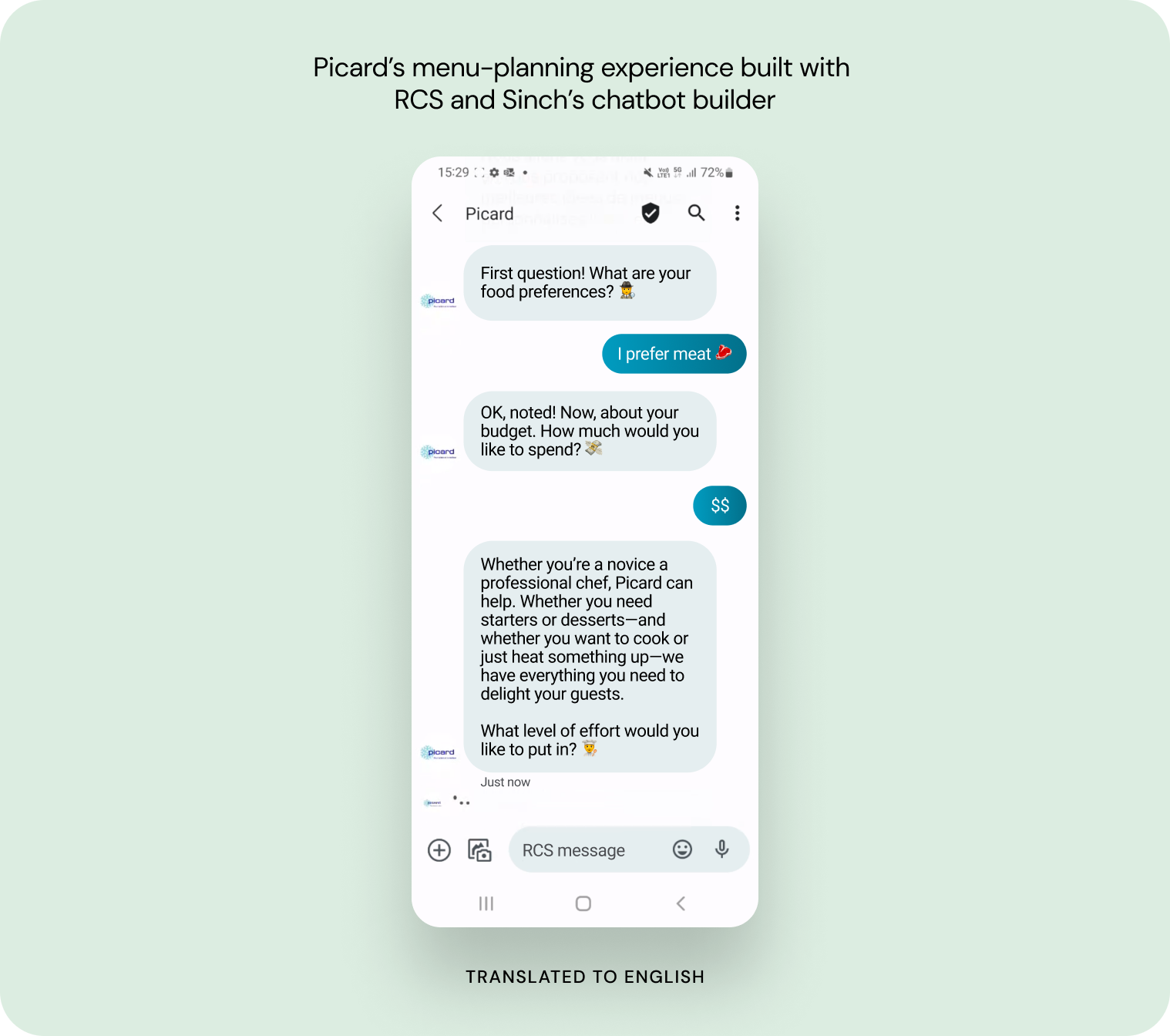
Using RCS, Picard customers could share details about their dietary preferences, budget, and willingness (or lack thereof) to cook — all within their native messaging app.
Based on their responses, they were presented with a personalized holiday menu and a call-to-action, directing them to the Picard website. And the results? Their RCS campaign saw a click-through rate 3x higher than that of Rich SMS, and 10% more website redirections than Rich SMS.
For more inspiration, read about five more holiday marketing campaigns using RCS to take your marketing to new heights.
2. Location-based promotions
RCS can supercharge your communication strategy to help you offer location-specific discounts and offers. For example, a restaurant could use RCS to send a discount to people within a certain radius, or a gym could offer a free trial session to those close by.
An example of RCS marketing working well for location-based promotions comes from Nissan, one of the world’s largest car manufacturers.
Seeing a dip in engagement from traditional channels, Nissan switched gears to using RCS to invite customers to their stores and test-drive their newest car models. Now, they use RCS to send subscribers custom messages about booking service appointments or sharing new cars that potential customers can take for a test drive.

Nissan uses RCS marketing to encourage potential customers to take new cars for a spin.
3. Product launches
One of the most promising aspects of RCS for marketers is its ability to help with storytelling. Instead of just telling people about your products, RCS makes it easy to show them in action.
That’s because RCS offers rich image carousels so users can browse through product images, descriptions, and prices. RCS makes it easy to click through images and explore different products right within the message itself.
For instance, ATOL, a chain of opticians in France, used conversational RCS to guide their customers through purchasing new eyeglasses and scheduling appointments.
In this campaign, people answered four questions that would determine a special offer made just for them, and then they'd be able to visualize their selection digitally. This personalized approach made people five times more likely to click on the RCS message than Rich SMS, and the RCS campaign boosted the rate of making an in-store appointment by 99% compared to Rich SMS.
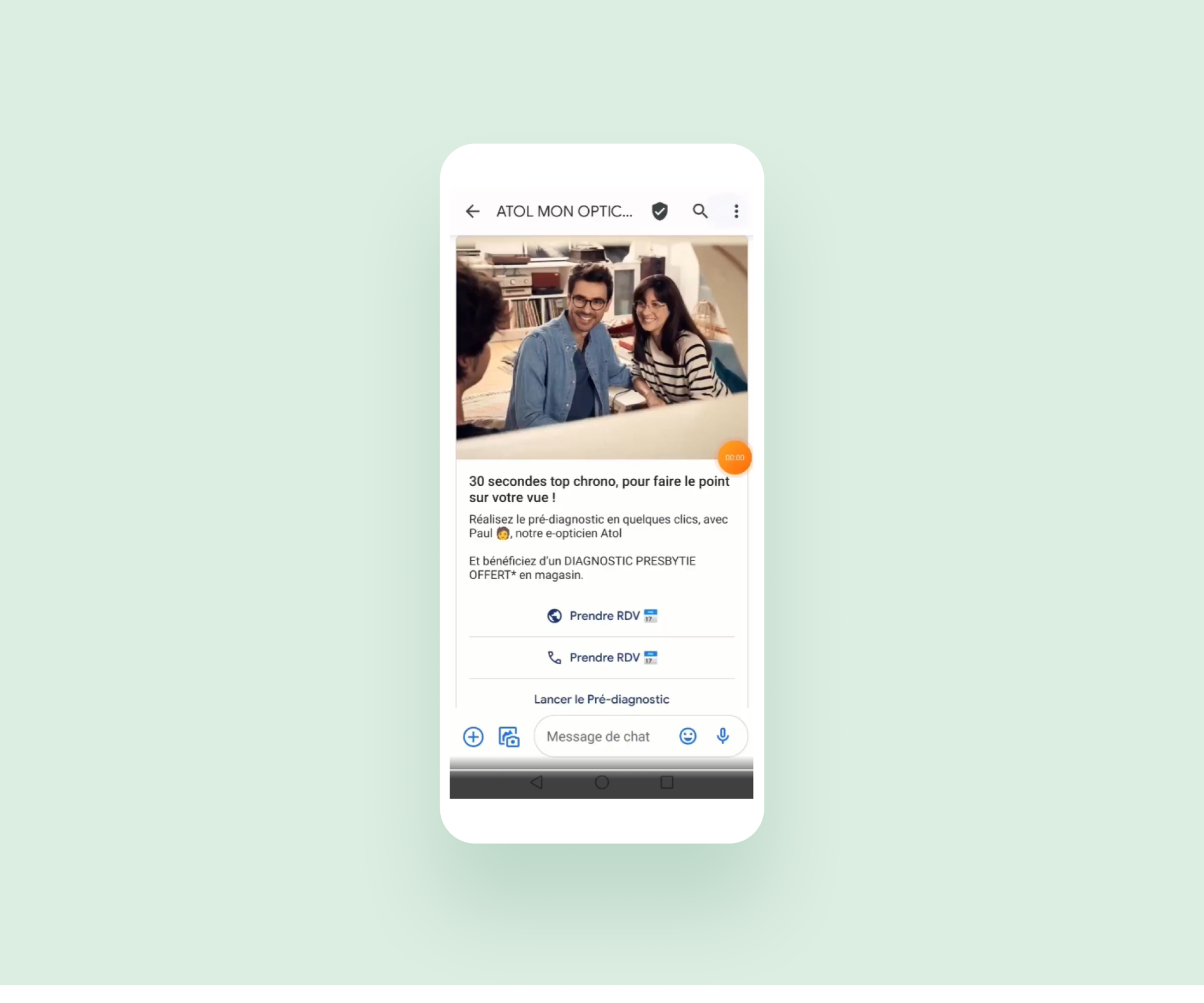
ATOL used conversational RCS marketing messages to give personalized advice and invite customers into their stores.
4. Replicating the in-store experience
RCS offers retailers the unique opportunity to recreate in-person shopping experiences in an immersive digital environment.
Take Printemps, a department store aiming to maintain its reputation by offering premium services. To meet this challenge, they deployed a personal shopper experience via RCS, essentially bringing the in-store experience to mobile devices.

Printemps used RCS marketing messages that allowed customers to shop for Father’s Day gifts based on their budget, preferences, and likes.
Their strategy led to an experience with a three times higher click rate than Rich SMS. RCS not only helped them enhance customer satisfaction but also strengthened their brand loyalty by delivering an online shopping experience that felt customized and attentive.
5. Black Friday and Cyber Monday
RCS is especially helpful for retailers that want to inform customers about early access to sales, give real-time stock updates, or to remind them about their abandoned cart during high-traffic shopping periods like Black Friday and Cyber Monday.
A great example of this comes from Citadium, a fashion retailer that aimed to boost revenue during Black Friday. They switched from traditional SMS marketing to RCS to send loyalty members personalized discounts and rewards, resulting in a 22% increase in conversions and an 85% engagement rate.

Citadium’s successful Black Friday and Cyber Monday strategy showcases how retailers can use RCS to drive sales during peak shopping periods.
6. Customer newsletters
You probably already send your customers an email newsletter. And there’s still a place for using email – but if you’re looking to promote an especially time-sensitive sale or have your message read more quickly, it could be a good idea to explore RCS.
Just a few days before Christmas, Micromania-Zing, part of retail giant Game Stop, used RCS as part of their omnichannel strategy mixing email newsletters and mobile messaging.
They targeted customers who hadn't yet purchased gifts with RCS messages. Their objective was to gain visibility and boost traffic in-store and on their website.
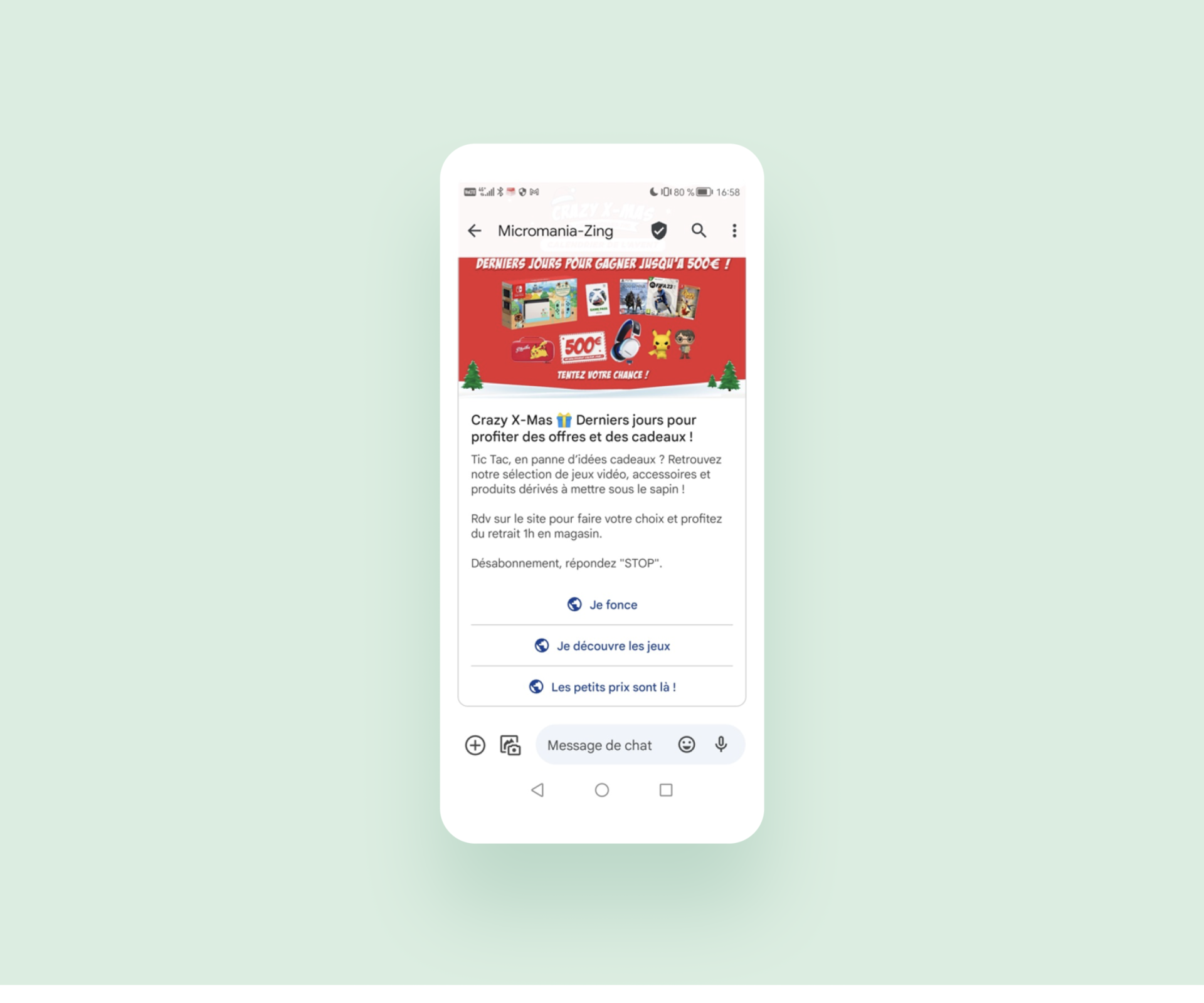
Micromania-Zing improved brand visibility and engagement by using RCS as a key part of their omnichannel marketing strategy.
The results were impressive: an 86% increase in read rate as compared to their email newsletter, and a 120% increase in web redirections versus Rich SMS.
When you use RCS for marketing, you can include images, videos, and clickable buttons directly in your audience’s mobile messaging inbox, creating a more immediate, immersive experience.
Trends that are shaping RCS marketing
Already we see more and more brands adopting RCS, with brands sending 25,000x more RCS messages in November 2023 than in February 2022. Here are what we see as the biggest trends that will shape how brands use RCS business messaging in the future.
-
Artificial intelligence (AI): As more and more enterprises begin to experiment with generative AI, integrating chatbots with RCS and other messaging channels will make customer experiences richer and more engaging.
-
Anti-spam measures: The rise in spam across various messaging channels positions RCS as a possible solution due to its baked-in security and verified business profiles.
-
Omnichannel marketing: 89% of customers want two-way conversations on messaging channels and apps, and they expect companies to know their preferences. Using RCS alongside other channels like email, SMS, and social media can help engage them across different touchpoints.
Get your RCS marketing strategy started
Now that you know the ins and outs of RCS marketing, isn’t it time to make it a part of your strategy?
An RCS marketing strategy can help your business with conversational commerce from the first time someone hears from you, through to their first purchase, and beyond. That's why RCS is a great channel to include in your omnichannel customer journey, helping you capture attention and motivate your customers to respond.
Ready to convince the rest of your organization about the value of RCS? Download our comprehensive RCS guide which will walk you through how to make the case to bring RCS marketing into your organization.
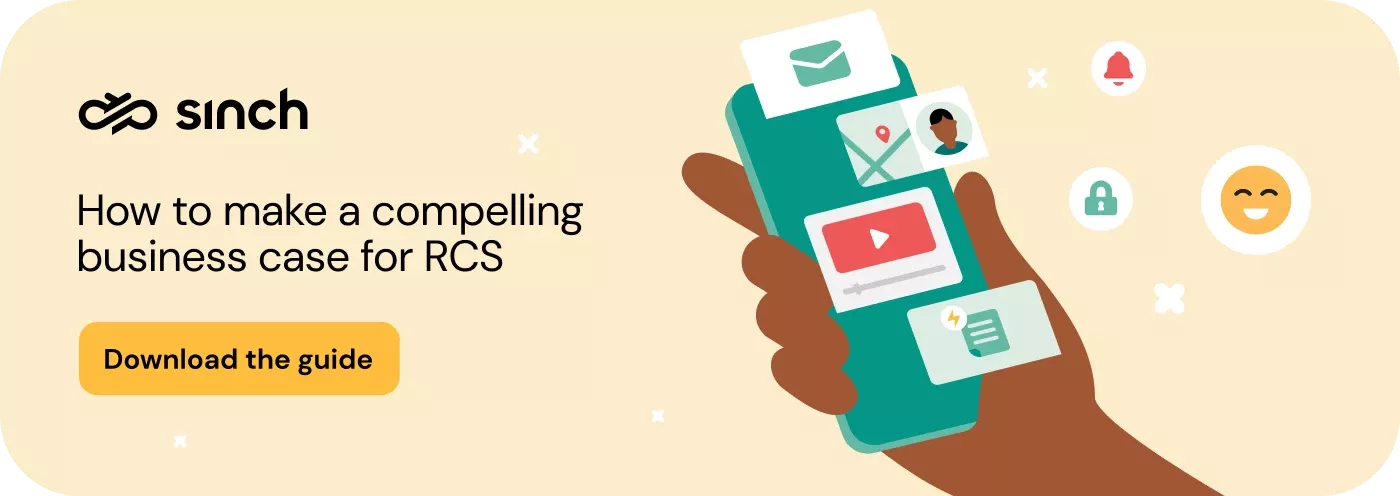
Or, if you’re ready to set up your RCS sender agent today, get in touch. Our team is excited to help you take your conversational marketing strategy to the next level!



